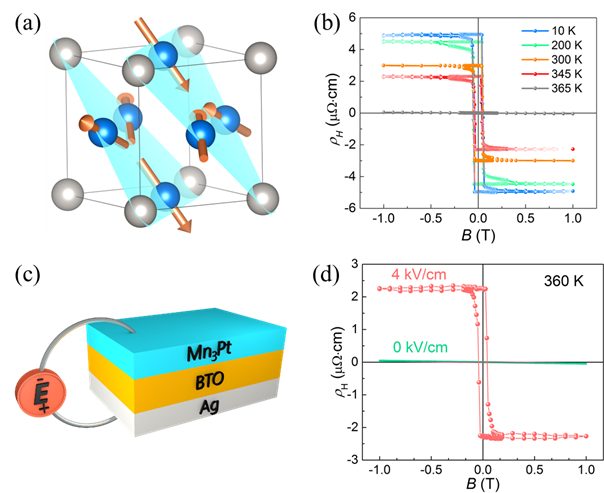The first device that enables electrical switching of the topological anomalous Hall effect (AHE) in a non-collinear antiferromagnet was published online in Nature Electronics by the team of Prof. Liu Zhiqi from the School of Materials Science and Engineering on March 9.

Fig. 1 The paper published online in Nature Electronics
As the world is experiencing a data explosion, ferromagnets, an important traditional medium in magnetic information storage in the digital age, lead to increasingly higher energy consumption, most of which comes from the ineffective Joule heat caused by the electric current used to generate magnetic field. Besides, storage devices based on ferromagnets are susceptible to the interference of surrounding stray magnetic fields, leading to demagnetization and consequently the loss of data.
Recently, antiferromagnetic spintronics has become a cutting-edge research field. Not having macro magnetism, antiferromagnetic materials have been playing an accessory role of pinning the magnetization direction in the head part of magnetic storage devices for years. The greatest advantages of antiferromagnetic materials include effective resistance to the interference of stray magnetic fields and the high-frequency dynamic characteristic of intrinsic spin. Besides, theoretical studies find that the AHE, which was thought to be limited to ferromagnets, can also be observed in some non-collinear antiferromagnets because of their special symmetry and Bloch-band topological features.

Fig. 2 A diagram showing the AHE in some non-collinear antiferromagnets
The team led by Prof. Liu produced high-quality thin films of the cubic non-collinear antiferromagnet Mn3Pt epitaxially grown on ferroelectric BaTiO3 substrates (Fig. 3(a)), in which obvious AHE was observed at room temperature. Furthermore, they could switch the effect on and off by applying a small electric field to the BaTiO3 substrate (Figs. 3(c) and 3(d)). The field could lead to piezoelectric strain transferred to the Mn3Pt film and make the spin structure of Mn3Pt change between the collinear state and the non-collinear state. Such switching, especially in zero magnetic field, is very conducive to the application of antiferromagnets.

Fig. 3 (a) Crystal and room-temperature magnetic structure of cubic Mn3Pt. Grey atoms are Pt and blue atoms are Mn atoms. (b) The AHE of the Mn3Pt film at various temperatures measured with magnetic fields applied out of plane. (c) Schematic of a 20 nm Mn3Pt/BTO heterostructure with an electric field E applied perpendicular to the BTO substrate. (d) The AHE is switched on and off by the electric field.
The electrical field applied to the BaTiO3 substrate only produces a negligible electrical current in it because of its good insulation performance. Therefore, coding in this way can effectively avoid the generation of Joule heat and greatly lower the energy consumption in information storage. In that case, this method can find its application not only in daily life but also in harsh magnetic field conditions, such as the spacecraft designed to explore celestial bodies with strong magnetic field like Jupiter and neutron stars.
Under the invitation of Nature Electronics, Prof. Christoph Sürgers, a celebrated expert in antiferromagnetic spintronics from Karlsruhe Institute of Technology, wrote a feature article on this study for the News & Views column of the same issue.
Besides Prof. Liu, Beihang researchers in the team also included Prof. Jiang Chengbao, Associate Professor Wang Jingmin, Dr. Liu Jinghua and two graduates, Feng Zexin and Yan Han. Prof. J.M. D. Coey, an internationally well-known expert in magnetics, also provided guidance for the research. Prof. Chen Hua from Colorado State University and Prof. AllanH. MacDonald from the University of Texas at Austin carried out the theoretical work and provided good physical explanation of the experimental observation results.
The research received support from the National Natural Science Foundation of China and Beihang University under the Ten-Thousand Talents Program for top young talents.
Reported by Xiao Jie
Edited by Shi Yue and Li Mingzhu
Translated by Li Mingzhu

